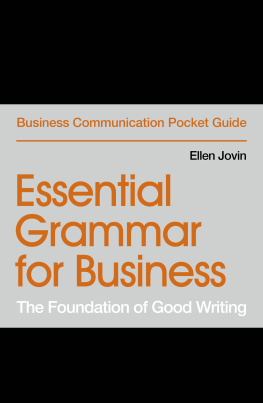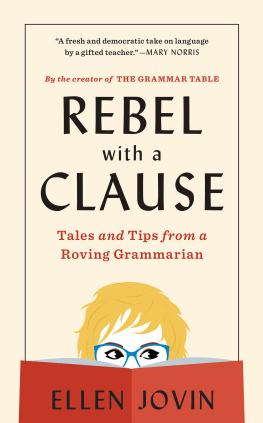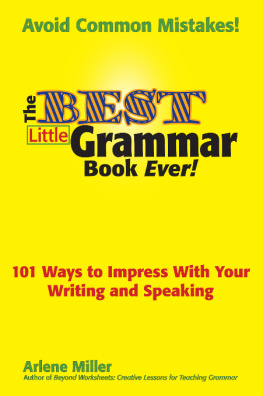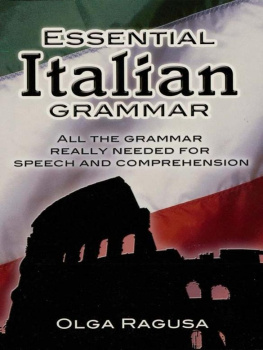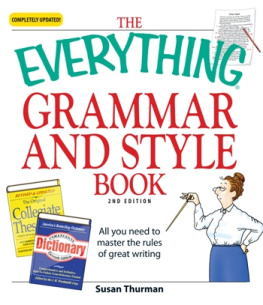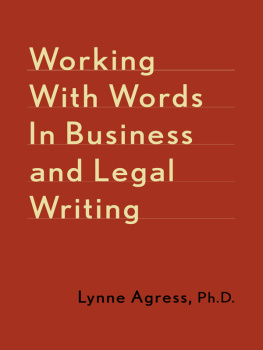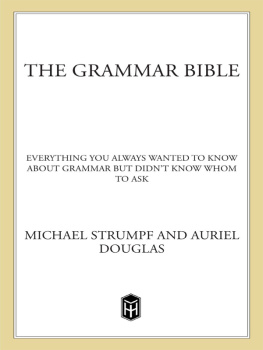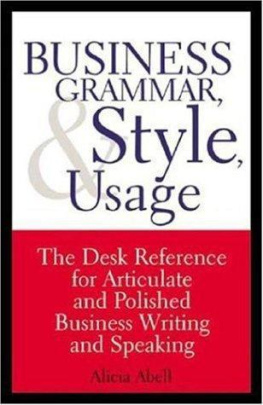
Contents
Page List
This edition published in 2019 by Nicholas Brealey Publishing
An imprint of John Murray Press
An Hachette UK company
23 22 21 20 191 2 3 4 5 6 7 8 9 10
Copyright Ellen Jovin, 2019
The right of Ellen Jovin to be identified as the Author of the Work has been asserted by her in accordance with the Copyright, Designs and Patents Act 1988.
All rights reserved. No part of this publication may be reproduced, stored in a retrieval system, or transmitted, in any form or by any means without the prior written permission of the publisher, nor be otherwise circulated in any form of binding or cover other than that in which it is published and without a similar condition being imposed on the subsequent purchaser.
A CIP catalogue record for this title is available from the British Library
A catalogue record for this book is available from the Library of Congress.
ISBN 978-1-52930-346-9
US eBook ISBN 978-1-52930-356-8
UK eBook ISBN 978-1-52930-348-3
John Murray Press Ltd
Carmelite House
50 Victoria Embankment
London EC4Y 0DZ
Tel: 020 3122 6000
Nicholas Brealey Publishing
Hachette Book Group
53 State Street
Boston, MA 02109, USA
Tel: (617) 263 1834
www.nbuspublishing.com
Introduction
The Foundation of Good
Writing
Grammar has a bad reputation. It is often regarded as dull, dry, mysterious, and frustrating. That is an unfortunate perspective. Gaining a deeper understanding of language and its structure can in fact be an exciting and rewarding activity. It is certainly a valuable one, with many practical professional benefits.
After all, a solid grasp of grammar is the foundation on which good writing rests. Good grammar is not by itself a guarantee of good writing, but good writing cannot exist without it.
The purpose of this small book is to provide guidance to professionals perplexed by questions about the proper placement of the comma, or the nature of dangling modifiers, or the difference between who and whom. With a better understanding of the building blocks of language, you will be better equipped to focus on other ingredients of good writing, such as content, clarity, and style.
Besides reviewing the grammar vocabulary necessary to a discussion of grammatical principlesverbs, pronouns, and clauses, for examplethis guide covers sentence structure, the rules of punctuation, and common problems in grammar and usage. It does not provide an exhaustive survey of these topics; instead, it focuses on the grammatical issues most relevant for business communications.
By improving your grasp of English and its structures, you will be better equipped to inform and persuade others in both writing and speech. Good grammar is a powerful tool, at work and in life.

Chapter 1
Parts of Speech
A basic and use this chapter for reference when you need it.
The Eight Parts of Speech
nouns
pronouns
verbs
adjectives
adverbs
prepositions
conjunctions
interjections
As you read through these descriptions, keep in mind that the same word can be a different part of speech depending on how it is used. For example, the word well can function as a noun, adverb, adjective, verb, or interjection. To determine part of speech, you will often need to examine how a word is functioning in a particular sentence.
Noun
The well ran dry.
Adverb
Ramn did well in his TV interview.
Adjective
Laila is not well today.
Verb
When I criticize Robins work, tears well up in his eyes.
Interjection
Well! Ive never been called that before.
1.1 Nouns
A noun refers to a person, place, thing, or idea. If you can perceive something through one of your five sensessight, sound, smell, taste, or touchit is probably a noun. Examples include:
| thinker | desk | noodle |
| notebook | stapler | medal |
| thunder | radish | car |
| courtroom | table | sushi |
| office | elevator | sandpaper |
Other nouns describe abstract ideas that cannot be perceived through the five senses. The word idea is an abstract noun! Here are some other examples:
| integrity | arrogance |
| belief | reason |
| reputation | information |
| justice | culture |
| creativity | motivation |
There are two special types of nouns worth noting here. The first is the collective noun, which describes a plural concept but is singular in form. Examples include:
| crowd | team |
| staff | board |
| faculty | couple |
| panel | group |
| committee | jury |
Collective .
Another special noun type is the proper noun, which refers to a specific person, place, thing, or idea. Joan Didion, New York City, and the American Bar Association are all examples of proper nouns.
1.2 Pronouns
A pronoun usually refers back to or replaces a noun or another pronoun. In the following sentence, for instance, the pronoun it refers back to the noun report.
Rochelle gave the report to Axel, who read it during lunch.
The word report is the antecedent for it. You can think of the pronoun in part as a tool for convenience; after all, without it we would have to write:
Rochelle gave the report to Axel, who read the report during lunch.
Pronouns dont always act as surrogates for other words, however. If you think of pronouns as vague versions of nouns, that may help you recognize them. Listed here are some common pronouns:
| I | which | no one |
| you | who | anybody |
| he | that | anyone |
| she | these | something |
| it | those | whoever |
| we | some | one |
| they | each | whom |
| me | everyone | neither |
| us | everybody | themselves |
| ours | nothing | either |
1.3 Verbs
Verbs usually describe existence or action and can be divided into three broad categories: action, linking, and auxiliary (or helping) verbs. Understanding these categories can help you recognize verbs more easily in a sentence.
1.3.1 Action Verbs
As their name suggests, action verbs generally describe action. Examples include:
| select | meet |
| write | invoke |
| invest | arrive |
| grumble | employ |
| sell | speak |
| react | advertise |
Not all action verbs, however, describe perceptible action. For instance, in the sentence Martha thought about the consequences, the verb
Next page
